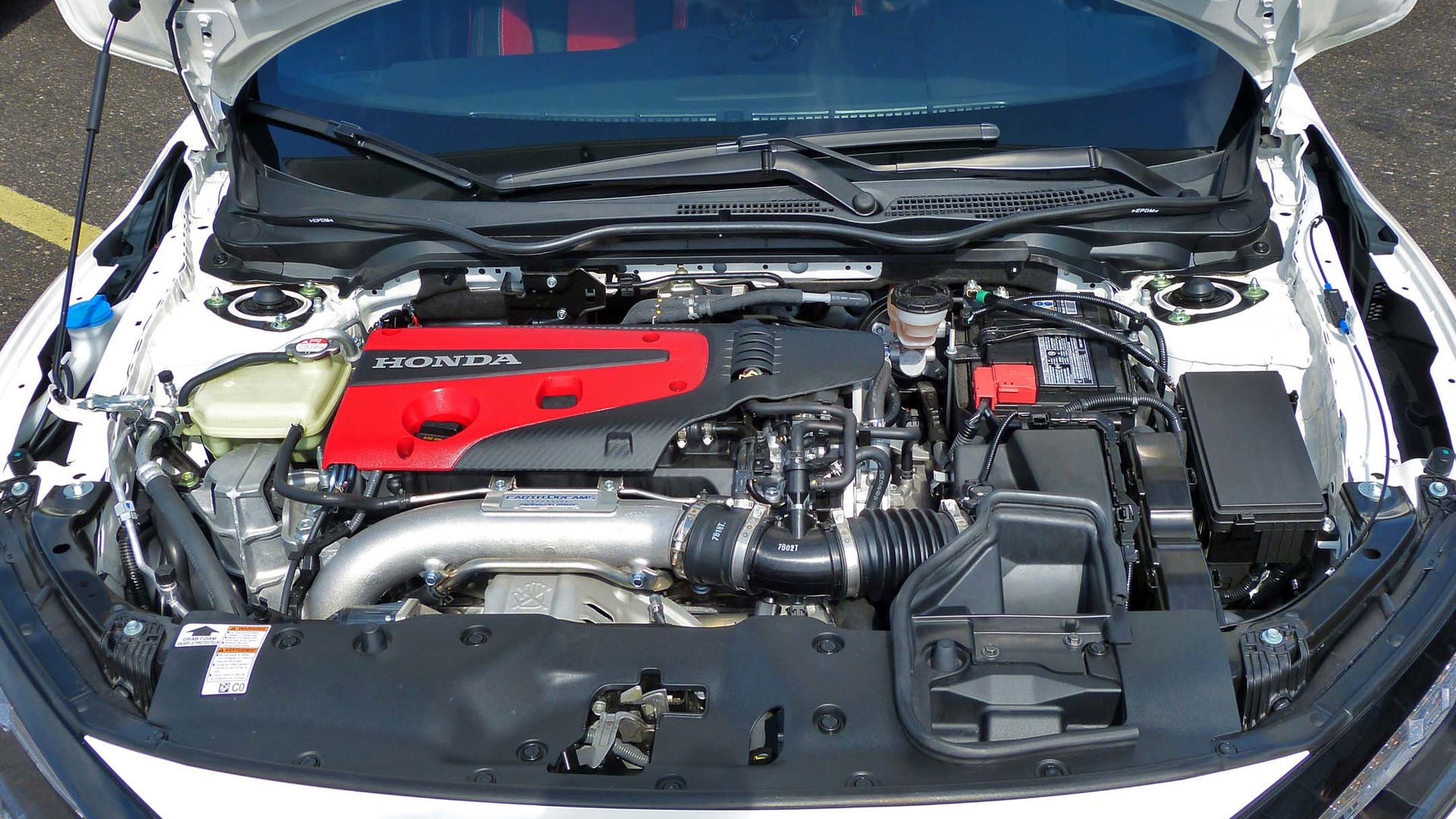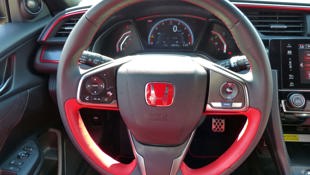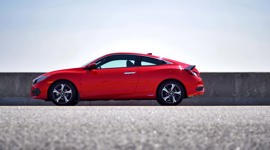Some 306 hp and 295 lb-ft of torque drags me through the final corner and onto the start-finish straight at Mont-Tremblant. A mechanical limited-slip differential and dual-axis strut suspension, plus twin-pinion electronic steering absorbs all trace of torque steer as I grab another gear and fire 1,415 kg of Honda toward turn one at a rate of knots.
The 2017 Honda Civic Type R is its own, unique, aggressive, excessive animal.
This is not a hotted-up Civic, it’s not even an extension of the Civic Si. The 2017 Honda Civic Type R is its own, unique, aggressive, excessive animal. The six-speed gearbox is unique to this iteration, the engine uses a different flywheel, cooled exhaust manifold, and bulk boost to force-feed bench-racer-satisfying power through the 2.0L turbo engine.
These days Honda is doing a “Porsche”, with several trillion iterations of Civic in three basic guises: sedan, coupe, and hatch. The $40,890 hatch-only Type R sits at the top of the Civic ladder in all regards. It is the most expensive, most alluring, and fastest – by a long, long way.
As I let the Civic dance under me on the brakes, the only thing more garish than the grin on my adrenaline-crazed face is the exterior of the Type R. Wings and winglets, air dams, skirts, and even a bonnet scoop all scream “racer”. Almost all of these add-ons ands widgets and gadgets are functional, with only exception being the two large black inserts at the edges of the rear bumper. The combination of cooling ducts, strakes and wings delivers what Honda claims is class-leading downforce.
Three exhaust tips protrude from under the rear bumper. The middle unit is slightly smaller, and acts like a resonator to improve low-speed sound and decrease high-speed droning. It’s perhaps the only real misstep here. The exhaust is too muted, too tame – too “Honda”. A car like this deserves to sound raucous. It should announce its arrival at the corner with burbles and explosions and theatre – and scream loud, obnoxious insults at you as it roars off into the distance.
Nürburgring, Nürburgring, Nürburgring
On the subject of shouting, Honda has done a lot of it about the 7m43s Nürburgring time the Civic Type R posted earlier this year. That time makes it the fastest front-wheel drive car around there ever, and bests times set by some relatively recent supercars, including the Lamborghini Gallardo, Audi R8 V10, and Porsche 911 GT2.
Honda says that the Nürburgring is the best test of a car like this, and has put a lot of stock in that time. The claim is that on a circuit with variable conditions, variable surfaces and variable types of corners, the Civic Type R shines ahead of competitors.
Those competitors, the Volkswagen Golf R, Subaru WRX STI and Ford Focus RS have one thing the Type R doesn’t have: all-wheel drive.
This is something that many say renders the Civic Type R the easy one to cross off that list. Honda’s response is that AWD is needless weight, and that its front-wheel-drive system delivers more than enough performance to match those cars. Indeed, they challenged us to be able to sense that the Type R is a wrong-wheel-drive car on the track.
What torque steer?
And here’s the thing: I couldn’t. I even went as far as to stop dead and accelerate hard in R mode, and while I could feel a bit of torque steer when I had traction control off, it was only slight. With TC on I couldn’t feel a thing, and certainly not when I was out in the rhythm and flow of the Tremblant circuit. Only a four-way, back-to-back comparison test will settle this issue properly, but on first impressions, the Type R feels fantastic.
There’s a bit of electronic trickery here, for sure, but also a large whack of mechanical and structural engineering. It starts with the strut towers. Unique to the Type R, Honda has employed two offset struts to locate and steer the front tires. So while one strut handles road-holding forces, the other takes on steering duties. Over the base Civic, this system adds 62 mm of track and one degree of negative camber and doubles the spring rate.
A set of 20-inch wheels clad in ultra-low profile P245/30ZR20 tires complete the suspension story.
The electric steering operates across two motors mounted alongside each other, and one is able to apply a different level of torque to the rack to compensate for unintended steering forces.
The final piece of the puzzle is a helical, mechanical (not electronic) limited-slip differential – a feature only recently added to special edition Ford Focus RS after repeated requests from fans. The result is a car that drives with excellent balance out of turns, pulling confidently and consistently down to the next corner.
Can you throttle-steer it and power-slide like a muscle car? Obviously no, but then again you can’t really do that in the Golf R or the STI either, and the Focus RS does it only with the help of electrickery.
The marriage of a multi-link rear suspension, trick dual-axis strut front suspension, and adaptive dampers make for a sharpened and honed handling package that is worlds apart from the already excellent Civic Hatchback on which the Type R is based.
Feeling fast
Honda has turned in another masterclass when it comes to developing a pleasing, engaging and snug-feeling gearbox and this engine is beautifully mated to the chassis.
With all 295 lb-ft on tap from 2,500 to 4,500 rpm and 306 hp peaking at 6,500, the 2.0L is a strong, linear engine that keeps hauling right up to the 6,500 rpm redline. On a track like this where the car is on boil all the time it was difficult to find any turbo lag. The Type R is quick, but not blistering - one expects there is room for the already-rapid aftermarket to get to work there.
The box will rev-match for you on downshifts, and does so impeccably – saving me a lot of hassle when I was focused on the track ahead. You can turn this feature off, but I didn’t, to be honest. And to be even more honest: neither will anyone else. They’ll claim they did, citing a desire for “pure driving” or claiming “I’m good enough to do it on my own, brah” but I guarantee you that 99.99 percent of drivers who say they turned off rev-matching are heel-and-toeing with the truth more than anything.
Besides which, it’s not like you need to work hard to have fun in this thing. Shifting weight around with throttle and brake inputs is as simple as if you were controlling it with a lever. You can trail-brake deep into the corners and the response from the steering is crisp and rapid. On Tremblant’s undulating circuit the Civic got light over crests, but settled down beautifully, and never broke loose unless I was trying to.
At 350 mm, the front brakes are the largest ever fitted to a Civic, and the four-piston Brembos bite hard and fast, hauling the Type R down to cornering pace with total authority.
In another world I’d ask for more road and steering feel, with the hydraulically assisted Subaru WRX STI giving the Type R and other rivals an absolute pasting on that front. But, sadly, hydraulic steering will soon be extinct.
Beauty is more than skin-deep
Inside the Civic Type R you’ll find the traditional Honda infotainment system, complete with Android Auto/Apple CarPlay. We’ve covered all these systems in our previous reviews of the 2017 Honda Civic Hatch.
Here again the Type R steps out on its own is with sexy racing seats. Unique to this trim, the sculpted racing buckets are heavily bolstered, finished in dramatic red and all ready for a five-point harness should you want to fit one. They held my wide-set 5'6" frame in place firmly while we hustled the Type R around a track, and I found them generally comfortable – though a proper road test will need to be done to confirm that.
You won’t find a sunroof – because stiffness – nor will you find a volume knob – because Honda hates user experience.
There is a red-accented, D-shaped steering wheel that feels great in the hands, and alloy pedals. On the console you’ll find a unique “Type R” ID plate with the car’s serial number, and next to that a drive select button.
Splitting personality
The drive select button puts the car into Sport (default), Comfort, or Type R mode. The settings control throttle response, steering assistance and the adaptive dampers, as well as the traction control intervention. The fully defeatable stability control system is at its most permissive in Type R, until you press the button to turn it off entirely.
Each driving mode is indicated by progressively more red on the instrument cluster graphics, and there are shift lights, boost gauges and other funky info screens available in Type R mode.
Pin-up
When I first drove the 2017 Honda Civic Hatchback I said that it is an ideal foundation for the incoming Type R. And indeed the UK-built hatch was always intended to form the basis of this new Type R. It may be the first we get in North America, but this is the sixth iteration of high-performance Civic.
For this writer, it’s easily the best.
With only 1,000 Type Rs available in Canada, this is very much a halo car in the lineup.
In it, Honda has a rig that is finally worthy of the heady fandom and praise it often receives. Not since Fast and the Furious has Honda had a way to engage and capture enthusiast audiences with a powerfully compelling and poster-worthy product.
One that properly earns the storied red “H” badge given to Type R models.
That Type R designation is special.
The 2017 Honda Civic Type R is spectacular.























































